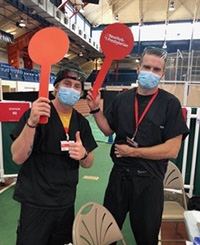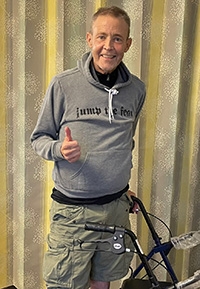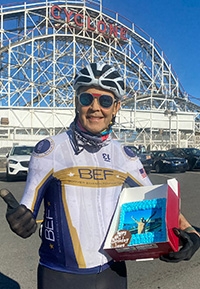It’s been another year of many challenges, but not one without triumphs. Time and time again, acts of courage, selflessness, innovation, and thoughtfulness shone brightly through the haze of pandemic life.
As 2021 comes to a close, we’re reminded of some incredible moments, exciting discoveries, and amazing people who led the way.
Community Stands Strong
Saving Lives on the Frontlines
 Volunteers traveled from near and far to help us vaccinate over 100,000 New Yorkers at The Armory earlier this year—from wildland firefighters and EMTs from the West Coast to our own faculty and staff here at home. Dedication to community drew us all closer than ever.
Volunteers traveled from near and far to help us vaccinate over 100,000 New Yorkers at The Armory earlier this year—from wildland firefighters and EMTs from the West Coast to our own faculty and staff here at home. Dedication to community drew us all closer than ever.
“Very early in the process, they realized they needed a lot more vaccinators, they asked the Columbia side to help and put out a request for volunteers. And, overnight they got 840. They were flooded with volunteers. They had to shut the site down,” said Dr. Craig Smith.

Each volunteer left an indelible mark on us. After a record-breaking fire season, we caught up with wildland firefighters Joe Lorenz and Noah Landguth, and their commitment to saving lives and saving our planet hasn’t let up.
Huge Win for Transplant Equity
For decades, experts and providers in the healthcare sphere have been pressing for a more equitable system of organ allocation. Dr. Jean Emond, Vice Chairman of Surgery and Chief of Transplantation Services at Columbia, has led the effort since the beginning, and Dr. Emond’s efforts, and those of many other advocates, were rewarded with a new liver distribution policy. One that doesn’t depend on where you live or if you have the money to put yourself on multiple waitlists.
“What happened for us in New York is that we immediately were exposed to a much larger geographic area of organ donors,” says Dr. Emond. “So we were able to see more transplants and do more transplants.”
Leading the Way in the O.R.
The Successful Separation of Conjoined Twins
Alusine and Isatu Jalloh traveled 4,300 miles from home to give their conjoined twin girls, Hassanatu and Hussainatu, the chance for a better life. Joined at the liver and chest wall, the nine-hour procedure involved more than 30 surgeons and specialists, including anesthesiologists, hepatologists, nurses, and technicians.
“Amid all that New York has faced in the past year, seeing the girls now walking side by side — still connected in spirit, though separated in body — is really such a treat. As opposed to some of the challenges and disheartening things that we saw, the girls really signify that, even in the midst of the global pandemic, there were still good things happening — and there were still some things that gave us reason to have hope,” said Dr. Thomas Imahiyerobo.
The process started months prior with tissue expanders inserted by Dr. Imahiyerobo. On the day of surgery, Dr. Emile Bacha, Chief, Division of Cardiac, Thoracic, & Vascular Surgery, separated the heart lining first, then Dr. Tomoaki Kato, Chief of Abdominal Organ Transplantation, separated the liver. Finally, Dr. Imahiyerobo, Director of Cleft and Craniofacial Surgery, and Dr. Steven Stylianos, Chief of Pediatric Surgery, separated the remaining tissues and completed reconstruction. Leaving Hassanatu and Hussainatu in their own bodies for the very first time.
First Covid-19 Lung Transplant and Triple Bypass
On St. Patrick’s Day, Gary Quinlan successfully underwent the first lung transplant and triple coronary bypass at New York-Presbyterian/Columbia after several weeks battling Covid-19. Covid pneumonia left such severe scarring in his lungs they could never recover. He needed new lungs, but the transplant procedure held grave risks and required highly calculated planning.
In a joint effort, our lung team, directed by Dr. Joshua Sonett, Chief of General Thoracic Surgery, and Dr. Selim Arcasoy, coordinated with heart surgeon Dr. Isaac George, Surgical Director of the Heart Valve Center, to design an operation that would save Gary’s life. By the time of his discharge after surgery, Gary had been in the hospital for 103 days. Today, he’s fully recovered and back to his old routines.
Cancer Surgery Gets a New Leader
We created a new Division of Surgical Oncology this year under the helm of Dr. Sam Yoon, an expert in gastric cancer, sarcoma, and melanoma. Operating on cancer requires so much more than surgical expertise, it requires a broad knowledge of the natural history of the disease, chemotherapy, radiation, and the best way to align treatment for each individual. With leaders like Dr. Yoon onboard, we’re taking huge steps toward optimizing cancer care.
In Treating Thyroid Disease, Less Is More
A new method of treatment called active surveillance means fewer people with thyroid disease are getting their thyroids removed. It’s part of a huge push to reduce the severity of surgical intervention for those who don’t need it. Coupled with cutting edge non-surgical treatments like radiofrequency ablation, or RFA, where we’re able to target the nodule and spare the surrounding tissue, Dr. Jennifer Kuo and Dr. James Lee are spearheading a transformation of thyroid care nationwide.
A Leader in Cystic Fibrosis Advocacy Gets Kidney-Liver Transplant

 Jerry Cahill was diagnosed with cystic fibrosis (CF) at age 10, and he’s been a lifelong fighter and advocate dedicated to empowering others. After a double-lung transplant at Columbia years ago, Jerry faced an entirely new challenge this summer: he needed a kidney-liver transplant. He went from biking in his annual Boomer Esiaon Foundation Ride to Breathe event straight to the hospital, and didn't expect he'd have to stay much less need a new kidney and liver.
Jerry Cahill was diagnosed with cystic fibrosis (CF) at age 10, and he’s been a lifelong fighter and advocate dedicated to empowering others. After a double-lung transplant at Columbia years ago, Jerry faced an entirely new challenge this summer: he needed a kidney-liver transplant. He went from biking in his annual Boomer Esiaon Foundation Ride to Breathe event straight to the hospital, and didn't expect he'd have to stay much less need a new kidney and liver.
The collaborative surgery lasted over 15 hours. Dr. Kato transplanted the liver first. Once the liver was in, vessels were connected and functioning, Dr. Joshua Weiner could transplant the kidney. “His recovery is remarkable,” said Dr. Kato. “Sometimes patients go into the ICU for a long time and end up needing multiple medical or surgical procedures to recover. He didn’t need those. That speaks for his physical strengths.”
Vein Treatment Steps Away from Traditional Surgery
It's all about laser therapy, radiofrequency therapy, and sclerotherapy—twenty-minute office procedures with no downtime at all. Vein treatment is an entirely new field, today most treatments are office-based procedures that don't require an OR or an incision, just local anesthesia and a few minutes. Through the latest technologies and leading clinical trials, Dr. Danielle Bajakian approaches state-of-the-art vein care as critical to improving the quality of life for the many who need it.
Advances in Breast Conservation Merge Plastic and Breast Surgery
Oncoplastic surgery is the interdisciplinary trend towards breast conservation that centers quality of life and the right to reconstruction after mastectomy. And it’s reforming the way we do breast cancer care.
Although guidelines offer a treatment model, the decision to pursue mastectomy versus lumpectomy with radiation is a complex one. It requires thoughtfulness and individualization, considering the patient’s personal goals and wishes at the forefront of treatment planning.
“The biggest advancement over the last few years is knowing how to use the different treatments in different orders, depending on the patient. We started to realize that tumor biology was equally as important, if not more, than actually taking the cancer out,” said Dr. Lisa Wiechmann.
Future-Defining Research Breaks the Mold
Groundbreaking Clinical Trial for Opioid Addiction Moves Forward
Phase 2 of a clinical trial studying the efficacy of the long-term naltrexone implant to curb opioid addiction and overdose opened for enrollment at Columbia. Dr. Christine Rohde, Chief of Plastic Surgery, discussed the impact of a type of implantable naltrexone that slowly dissolves in the body, continuously releasing an effective dose of the opioid antagonist for about 6 months.
Pancreatic Cancer Requires a Holistic Approach
As Dr. John Chabot has said time and time again, it’s about treating the “whole patient.” From advances in pancreatic cancer genetics research to immunotherapy to greater applications of surgery, The Pancreas Center is developing treatments that combine immunotherapy and chemotherapy, using medical therapies that target the unique way pancreatic cancer cells use energy sources. For their efforts, the Columbia program has been named Center of Excellence for Pancreatic Cancer by the National Pancreas Foundation.
Tumor Microenvironments Are All Different
Dr. Sandra Ryeom, head of the Ryeom Lab, joined Columbia this year, bringing her work that explores and analyzes the differences in tumor environments. Her team found that these microenvironments differ greatly depending on the organ. An endothelial cell in the lung is completely different from, say, one in the liver or breast. This discovery has opened up a new understanding of cell environments in various diseases and conditions, from cancers to infertility.
Columbia’s Ride to End Cancer Raises 1.1 Million in 2021

This year marked the fifth annual Velocity Ride, bringing together supporters of the Herbert Irving Comprehensive Cancer Center (HICCC), Columbia Surgery, and Columbia Medicine to raise money for innovative cancer research and care.
Thousands of people, from cancer patients to physicians and staff, have raised over $6 million for cancer research at Columbia. An effort that will continue to save countless lives year after year.
Mentorship Takes Center Stage in More Ways Than One
Tying Better Surgical Knots the Dr. Smith Way
Dr. Craig Smith, Chair of the Department of Surgery, breaks with conventional wisdom on tying surgical knots and created a tutorial that upends the prevailing instruction. As he explains, “Surgical knots need to be tight enough but not too tight. Tight enough to accomplish their mission but not so tight that the suture breaks or pulls through the tissue.” And he took us through the lesson step by step.
Colorectal Surgeon Steps Out of Retirement to Mentor Young Surgeons at Columbia
After 32 years in practice as a colorectal surgeon, building a world-class colorectal clinic, and mentoring countless surgeons in Ohio, Dr. James Church retired from practice at the Cleveland Clinic. But retirement didn't last long. Soon he was on a plane to New York City to embark on a new chapter of mentorship—sharing the wisdom that comes from decades of experience with a new generation of colorectal surgeons.
“Most surgical textbooks are full of evidence-based medicine, it’s the buzzword of the day. But I’ve developed ways of looking at disease, of doing things that patients like, which are generally not practiced and I think that’s a problem,” said Dr. Church.
His ground-breaking awake colonoscopy techniques, treatment of anal fistulas, and colorectal genetics research are only the beginning of what he aims to teach. Dr. Church’s philosophy hinges on a central question: what makes a good surgeon? And to him, it’s the ability and desire to wonder.
A World of New Techniques in the Repair of Hernias
From complex to simple, robotics are at the forefront of transformation in hernia surgery. Robotic surgery is changing outcomes, rate of reoperation, and ushering in a new class of surgeons who specialize in the repair of complex hernias. Dr. Yuri Novitsky, Director of the Comprehensive Hernia Center, teaches new techniques, materials, and approaches on the national stage, while hernia surgeon Dr. Dina Podolsky has led advanced robotic training for surgical residents at Columbia.
“It gives me a lot of optimism that we continue to exponentially spread the word and improve the overall level of hernia surgery in the United States,” says Dr. Yuri Novitsky. “I'm very optimistic that this movement will only continue to grow. Complications will become much more rare, and recurrences will become rarer and rarer too.”
In the U.S., Heart Failure Treatments Are Stuck in the Past—We’re Changing That
Heart failure deaths are increasing rapidly, and one key factor in the rise? "Most physicians' mindsets haven't evolved," says. Dr. Nir Uriel, Director of Advanced Heart Failure and Cardiac Transplantation. “If you look at the recent journal paper that came out about compliance, we wanted every heart failure patient—even without going on a sophisticated therapy—to at least be on three medications. Only a minority of patients get them, and of that minority, only 1 percent gets the right doses. That’s how bad it is.”
Heart monitoring technologies, new applications of existing medications, and new medications entirely are ushering in a transformative era of heart failure care. From the evolution of LVAD as a bridge to transplant to long term life-saving tool to the continuous merging of medical and surgical applications, our heart team is leading the hybrid revolution.
